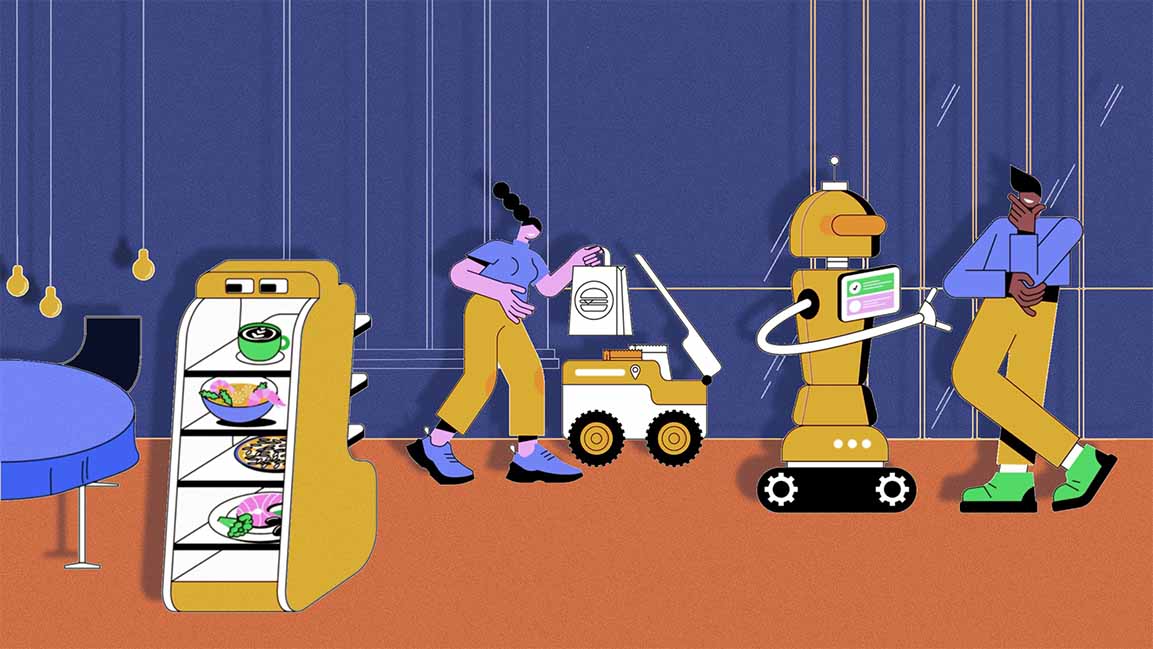- | 9:00 am
Will personal robot ownership overtake smartphones in the Middle East?
With pilot projects of self-driving cars, autonomous delivery drones and robots, and body language scanning humanoids, how far is the Middle East from a fully digital robotic future? We ask experts.

Here’s the thing: Modern technology is designed to bring the world to you, but if trends continue, robots will soon get you everywhere. In contemplating the future of cities, the role of robots comes into focus. How do we design robots that humans will embrace? Are we on the brink of a robot-dominated world?
Gitex Global unveiled many robotic iterations, each showcasing diverse functionalities such as body language scanning, security robodogs, customer service droids, and more.
The global deployment of autonomous robots is ushering in a new industrial era. These robots are powered by advanced artificial intelligence and machine learning capabilities, altering the landscape of work, life, and human-technology interaction.
Industrial settings and manufacturing have found autonomous robots to be indispensable. These machines boost efficiency, cut operational costs, and elevate safety standards. As per the International Federation of Robotics (IFR), the tally of industrial robots worldwide surpassed 2.7 million in 2020, with projections signaling continued expansion.
In the UAE, the ascent of robots is visible. They have been integrated into various sectors, from manufacturing and logistics to healthcare and education. Among them, Kiwibot, the food delivery robot, is facilitating meal deliveries by partnering with Aramex earlier this year.
So, what are the prerequisites for a broader robot rollout?
“If a community or country aims to implement autonomous robots for deliveries, it will be simpler if the existing infrastructure complies with accessibility. The general rule is, if it’s accessible for a person in a wheelchair, it will be accessible to a robot,” says Felipe Chavez, CEO of Kiwibot.
Financially, the investment threshold is steadily decreasing. “Now we are at a point where we can deploy a few robots with minimal investment. We typically consider deploying robots in locations such as college campuses and gated communities, where there’s a shortage of personnel for goods movement,” he adds.
A World Economic Forum (WEF) study predicts that adopting autonomous robots in logistics could translate into significant cost savings and efficiency gains.
The sphere of autonomous vehicles, including self-driving cars, is at the forefront of attention in the mobility industry. According to a study by McKinsey & Company, self-driving vehicles could constitute a substantial share of all vehicle sales by 2030, revolutionizing the automotive and transportation sectors.
“Middle Eastern cities should adapt their infrastructure to accommodate autonomous robots by aligning with the ongoing smart city development and planning trend. Crafting the necessary strategies can pave the way for extensive robot deployment across various sectors,” says Dr. Mohammad Jaradat, Professor of Mechanical Engineering at the American University of Sharjah.
A MULTIMODAL FUTURE
We’re still in the early days of that multimodal future. It’s a future with ground robots, drones, self-driving cars and trucks, and people on electric scooters. “Right now, the pilot we ran in Dubai, we’re starting to propose what that future may look like,” says Chavez.
But, the main challenges from a multimodal perspective are that drone companies must ensure the drone component is scalable and meets regulatory approvals, according to Chavez. “Ground robot companies are focused on ensuring that sidewalks are navigable, and self-driving car companies are dedicated to perfecting their technology. Each unit in the multimodal world concentrates on its segment, but in the coming years, we will begin to see integration and scaling.”
The most significant challenge, he believes, is time and patience. “It’s about ensuring that each piece of the puzzle matures sufficiently to start integrating with other components.”
Deployment of robots in cities can help lower the carbon impact since they depend on electrical energy for operations, such as transportation and delivery services. “With the aid from solar power charging units for these robot systems, cities can improve their sustainability to provide various services depending on these robot systems,” says Dr. Jaradat.
BEYOND THE HYPE
According to experts, automating manual, repetitive tasks is the path forward.
“People are eager to engage in meaningful, intellectually challenging work. By automating repetitive tasks, people will have the opportunity to pursue higher-level jobs,” says Chavez.
Additionally, uncertain future weather conditions in places like Saudi Arabia and the UAE, where high temperatures hinder goods movement, underscore the importance of investing in robotic infrastructure. “It is vital to connect futuristic technologies, enabling them to interact seamlessly,” he adds.
One of the challenges in large-scale robot deployment is charging times. Chavez concedes that mounting a solar panel on a ground-level robot is physically unfeasible. “Currently, the robots in Dubai are powered through a charging station.”
HOW LONG BEFORE MASS-SCALE ADOPTION
In terms of leadership in this transformative wave, South Korea is at the forefront as the first country with more robots than human employees on a global scale. In terms of growth, the Middle East is actively investing in cutting-edge robotics technologies for deliveries, with drones and autonomous vehicles undergoing testing and deployment in conjunction with the US. China, too, leads in the supply and development of hardware.
“By the end of this decade, we will have at least ten times more robots than smartphones. Each person will likely own three to ten robots to simplify their lives. They will handle tasks we’d rather not do, ensuring we can continue doing what we want to do,” Chavez says.
If it works, robots won’t just change our lives in the future, they’ll expand them. Not just for fun but out of necessity.








































